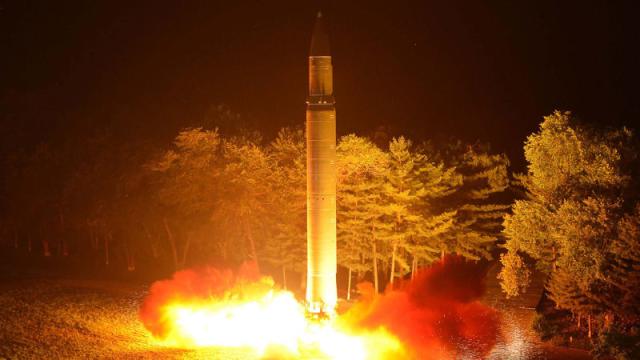In the last few months, North Korea’s ability to launch a warhead beyond its backyard has improved exponentially. Its rapid development of intercontinental ballistic missile tech has left many confused. Now a researcher at the International Institute for Strategic Studies claims he might have solved the mystery. North Korea may have received its new souped up ICBM tech from a factory in the Ukraine, and it probably did so very illegally.
Photo: AP
In a new study, researcher Michael Elleman examines recent photos of Kim Jung-un inspecting the suspiciously capable new rocket engines in order to determine their origin. He and his fellow researchers noticed the engines were of a design very similar to one used by the Soviets to launch up to 10 thermonuclear warheads at a time. He also determined, based on footage of the rockets launching, plus reports from North Korea, Japan, South Korea and the US, exactly what version of the rocket was likely being used.
From there he narrowed down the rocket to a specific manufacturer in Ukraine who, coincidentally, is in dire financial straits. Elleman’s evidence, while largely circumstantial, is extremely striking. North Korea made “astounding strides over the past two years”, employing technology that was in use by the USSR since the ’60s and should have been well out of North Korea’s reach.
He hasn’t been alone in his investigation. Others, including more experts and government investigators, have been studying the potential origins of North Korea’s new tech and settled on a single Ukrainian factory, Yuzhmash. In an interview with the New York Times, which first reported the study, Elleman said, “It’s likely that these engines came from Ukraine — probably illicitly.” Later he adds, “The big question is how many they have and whether the Ukrainians are helping them now.”
That is one of the major question marks in this tale of international intrigue. The missile tech might have been acquired from Yuzhmash via the black market. It wouldn’t be the first time: In the ’70s and ’80s North Korea acquired its missile tech illegally from the USSR. Then in 2004, the father of the nuclear bomb program in Pakistan, A.Q. Khan, admitted to selling nuclear secrets to North Korea. Khan had, himself, stolen those secrets from labs in the Netherlands in the ’70s.
Alternatively, North Korea might have simply stolen the tech from Yuzhmash (or a similar site). In Elleman’s report he quickly discounts that theory. “The alternative hypothesis, that Russian/Ukraine engineers were employed in North Korea is less likely, given the absence of any known production facility in North Korea for such engines.”
With no factories capable of building the rockets at the heart of North Korea’s new missiles, all signs point to the country acquiring actual devices and not just schematics. Missiles are enormous and would have been very obvious when crossing a continent. This calls into question the entire surveillance apparatus around the country, and strongly indicates help from a third party, either a separate nation state — such as Russia or China, or an extremely organised criminal organisation.
In the report Elleman notes that the Soviet rocket (referred to as an LPE) North Korea appears to have acquired “is no longer employed by operational missiles or launchers”. Thus “facilities warehousing the obsolete LPEs are probably loosely guarded. A small team of disgruntled employees or underpaid guards at any one of the storage sites, and with access to the LPEs, could be enticed to steal a few dozen engines by one of the many illicit arms dealers, criminal networks, or transnational smugglers operating in the former Soviet Union.”
Whatever the source, everyone can agree that North Korea’s latest missile launches were more successful than any iteration before. Though, as noted by the Bulletin of the Atomic Scientists, the technology is not quite capable of hitting the continental US. While Elleman agrees with that assessment, he also notes that without intervention, North Korea might be capable of reaching the US mainland with a missile by 2018.
That’s why Elleman ends his report urging other nation-states to negotiate an agreement that bans further testing by North Korea and effectively kills its ICBM program. “But” Elleman warns, “the window of opportunity will soon close, so diplomatic action must be taken immediately.”
[IISS via The New York Times]
